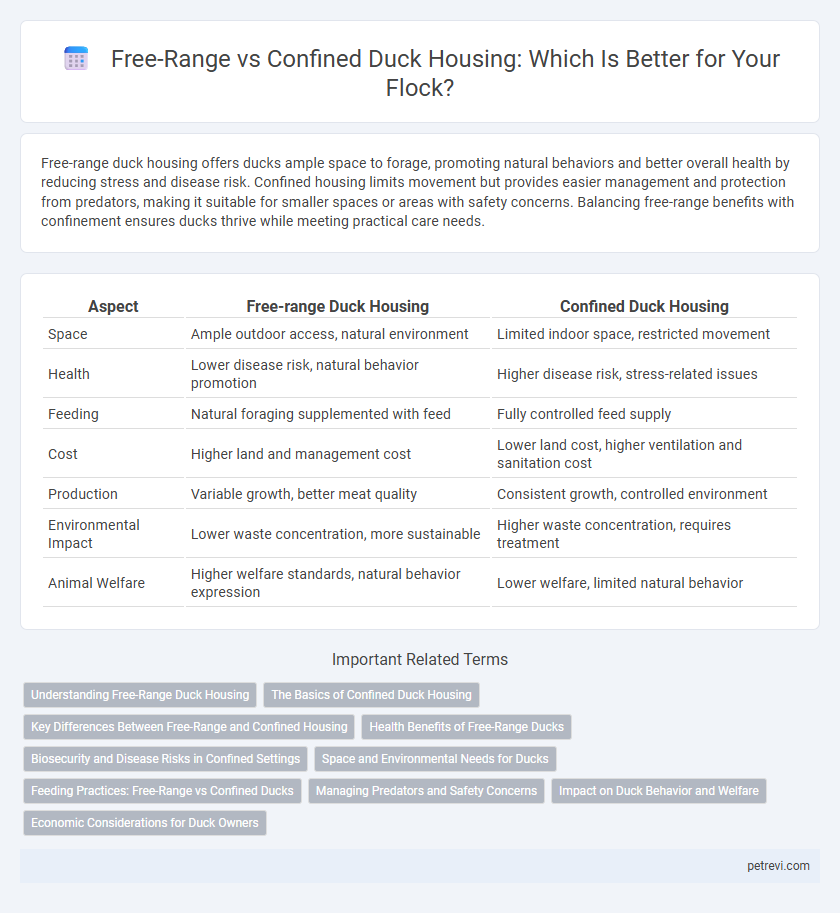Free-range duck housing offers ducks ample space to forage, promoting natural behaviors and better overall health by reducing stress and disease risk. Confined housing limits movement but provides easier management and protection from predators, making it suitable for smaller spaces or areas with safety concerns. Balancing free-range benefits with confinement ensures ducks thrive while meeting practical care needs.
Table of Comparison
| Aspect | Free-range Duck Housing | Confined Duck Housing |
|---|---|---|
| Space | Ample outdoor access, natural environment | Limited indoor space, restricted movement |
| Health | Lower disease risk, natural behavior promotion | Higher disease risk, stress-related issues |
| Feeding | Natural foraging supplemented with feed | Fully controlled feed supply |
| Cost | Higher land and management cost | Lower land cost, higher ventilation and sanitation cost |
| Production | Variable growth, better meat quality | Consistent growth, controlled environment |
| Environmental Impact | Lower waste concentration, more sustainable | Higher waste concentration, requires treatment |
| Animal Welfare | Higher welfare standards, natural behavior expression | Lower welfare, limited natural behavior |
Understanding Free-Range Duck Housing
Free-range duck housing allows ducks access to outdoor areas, promoting natural behaviors such as foraging, swimming, and social interaction, which improves their overall welfare and health. This system often includes shelter for protection from predators and harsh weather while ensuring adequate space per bird, typically exceeding 5 square feet of outdoor area per duck. Proper management of free-range environments reduces the risk of disease transmission common in confined housing by improving ventilation and reducing stress levels.
The Basics of Confined Duck Housing
Confined duck housing involves keeping ducks within a controlled indoor environment designed to optimize health, productivity, and biosecurity. Key elements include adequate ventilation systems, temperature control, and space allocation to minimize stress and disease spread. Proper management of feed, water, and waste ensures efficient growth and comfort in these densely populated settings.
Key Differences Between Free-Range and Confined Housing
Free-range duck housing allows ducks to roam outdoors, promoting natural behaviors and access to sunlight, which enhances their overall health and egg quality. Confined housing restricts movement to indoor spaces, focusing on higher density and controlled environments to optimize space and reduce disease exposure. The key differences lie in animal welfare, environmental impact, and management practices, with free-range systems supporting better welfare but requiring more land and labor.
Health Benefits of Free-Range Ducks
Free-range ducks exhibit improved respiratory health due to better air quality and reduced ammonia exposure compared to confined systems. Access to natural foraging in free-range environments enhances their immune function through diverse nutrient intake and increased physical activity. This housing method significantly lowers the risk of disease transmission often seen in overcrowded, confined conditions.
Biosecurity and Disease Risks in Confined Settings
Confined duck housing increases biosecurity by limiting exposure to wild birds and environmental contaminants, significantly reducing risks of avian influenza and bacterial infections. Controlled environments allow for targeted sanitation protocols, minimizing pathogen transmission through feed, water, and bedding. However, overcrowding and poor ventilation in confined systems can exacerbate disease spread if biosecurity measures are not rigorously maintained.
Space and Environmental Needs for Ducks
Free-range ducks require ample space with access to outdoor waters and natural vegetation to support their foraging behavior and social interactions, promoting higher welfare and natural health benefits. Confined housing demands careful environmental control, including adequate ventilation, temperature regulation, and clean, dry bedding, to prevent disease and stress in limited space. Optimal duck housing balances space allowance--ideally 4 to 6 square feet per bird in confinement--and environmental enrichment to meet ducks' natural needs for swimming, roaming, and nesting.
Feeding Practices: Free-Range vs Confined Ducks
Free-range ducks forage naturally, consuming a diverse diet of insects, plants, and small aquatic animals, which enhances their nutrition and promotes healthier growth. Confined ducks rely on formulated feed, typically composed of grains, proteins, vitamins, and minerals, designed to meet optimal growth rates but may lack the nutritional variety found in free-range diets. Feeding practices impact overall duck health, flavor profile of the meat, and sustainability of the production system.
Managing Predators and Safety Concerns
Free-range duck housing requires robust predator-proof fencing and regular monitoring to prevent attacks from foxes, raccoons, and birds of prey, ensuring ducks can forage safely outdoors. Confined duck housing offers enhanced protection through secure enclosures and controlled access points, significantly reducing the risk of predator intrusion. Implementing nighttime shelters and deterrents like motion-activated lights further increases safety, minimizing stress and injury among ducks.
Impact on Duck Behavior and Welfare
Free-range duck housing promotes natural behaviors such as foraging, swimming, and social interaction, which enhances overall welfare by reducing stress and aggression. Confined housing often restricts movement and prevents expression of instinctive activities, leading to increased signs of distress, feather pecking, and compromised immune function. Research consistently shows that ducks in free-range systems exhibit healthier physical and psychological states compared to those in confined environments.
Economic Considerations for Duck Owners
Free-range duck housing often requires more land and labor but can lead to higher market prices due to perceived quality and animal welfare benefits. Confined systems reduce land use and improve feed efficiency, lowering operational costs and allowing for higher stocking densities. Economic considerations must balance initial investment, ongoing expenses, and potential revenue to determine the optimal housing system for profitability.
Free-range vs Confined for Duck housing Infographic

 petrevi.com
petrevi.com